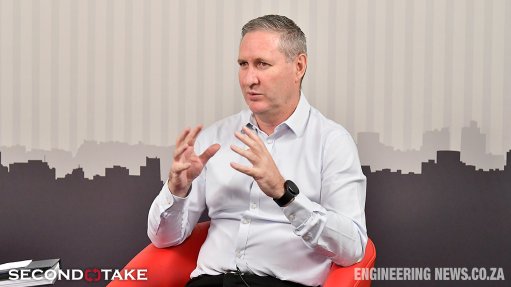Cost of nuclear likely to be lower than dreaded, expert asserts
Nuclear physicist and senior lecturer in North-West University’s School of Mechanical and Nuclear Engineering Dr Dawid Serfontein (who holds a PhD in nuclear engineering) has rejected the oft-quoted estimate that South Africa’s planned programme of new nuclear power plants (NPPs) would cost the country R1-trillion.
“There is no reliable source that gives R1-trillion,” he told a recent Nuclear Roundtable in Johannesburg.
He affirmed that the programme to build 9 600 MW of new nuclear power generating capacity would not only cost less than this but, in the end, generate good profits. He stressed, however, that his estimate was expressed in constant 2012 rands – that is, 6% inflation was removed. This was done because it was the approach adopted in the 2013 version of the 2010 Integrated Resource Plan (IRP), on which he based his calculations. A newer IRP has not yet been released.
Under these conditions, he estimated the entire new nuclear programme would cost the country less than R650-billion. This would cover all 9 600 MW, all construction costs (at an assumed overnight cost of R46 500/kW installed, spread over a six-year construction period), plus 17% owner costs, plus 3% real interest a year (which is the 9% nominal interest rate Eskom currently borrows at, less 6% inflation), which would take the amount to R581-billion.
“However, the first plant can be expected to cost substantially more and take substantially longer to build,” he cautioned. “Adding these costs then gives an estimate of R650-billion, which excludes upgrades to the power grid for transmission and distribution. But interest paid after the commissioning of the plants would easily be dwarfed by the revenues generated by those NPPs.” Because each of the new NNPs would operate for more than 60 years, each would pay off all its debts in about 20 years and generate large profits over the subsequent 40 years. “If these assumptions change – for example, if construction costs prove to be much higher, my estimates would, of course, be wrong,” he noted.
One change has been the decline of the rand against the dollar. Because of this, Serfontein expressed the view that dollar-based US nuclear technology would now be unaffordable for South Africa. However, as the rouble had fallen even further against the dollar, Russian nuclear technology should still be affordable, provided the costs were rouble-based (even if they are eventually expressed in dollars). Technology from China and other countries whose currencies had similarly devalued against the dollar were also likely to remain affordable. It should further be noted that a large fraction of the costs – labour, cement, steel – would be incurred within South Africa and so would not be sensitive to the devaluation of the rand.
He highlighted that the critical issue for the financing of the proposed new NPPs was the Weighted Average Cost of Capital (WACC) – that is, the return the government demands on the capital it invests in Eskom. If this was too high, nuclear power would be more expensive than the other options. If it was low, nuclear power would be substantially cheaper than new coal power.
The critical point for WACC for the new nuclear programme is about 8.3% (in real terms), which the National Treasury has now declared to be the norm. If the construction cost then turns out to be much higher than expected, nuclear power will cost more than the other options. At or below a WACC of 8.3%, nuclear power would be cheaper than its competitors. He stated that government could borrow at an interest rate of 3%.
“ [The National Energy Regulator of South Africa] says [national State-owned electricity utility and current NPP operator] Eskom’s WACC should be only 5%, in which case nuclear power will definitely be cheaper than the other options, such as coal, wind and photovoltaic solar, even if the nuclear construction cost turns out to be much higher than my estimates,” Serfontein pointed out.
“It should, however, be noted that, at a WACC of 8.3%, the lion’s share of the cost of nuclear power would be profit to the government. Government’s breakeven cost is roughly the 3% interest rate it pays on debt. At this breakeven WACC, nuclear power is much cheaper than its competitors. It is therefore virtually impossible that nuclear power would be produced at a loss, even if the nuclear construction costs turn out to be very high. Therefore, the often expressed fear that the nuclear programme would bankrupt the country or would drown us in debt for generations to come is simply out of line with the numbers.”
The roundtable was organised by local com-pany Nuclear Africa. It was sponsored by Russian State-owned nuclear group Rosatom.
Comments
Announcements
What's On
Subscribe to improve your user experience...
Option 1 (equivalent of R125 a month):
Receive a weekly copy of Creamer Media's Engineering News & Mining Weekly magazine
(print copy for those in South Africa and e-magazine for those outside of South Africa)
Receive daily email newsletters
Access to full search results
Access archive of magazine back copies
Access to Projects in Progress
Access to ONE Research Report of your choice in PDF format
Option 2 (equivalent of R375 a month):
All benefits from Option 1
PLUS
Access to Creamer Media's Research Channel Africa for ALL Research Reports, in PDF format, on various industrial and mining sectors
including Electricity; Water; Energy Transition; Hydrogen; Roads, Rail and Ports; Coal; Gold; Platinum; Battery Metals; etc.
Already a subscriber?
Forgotten your password?
Receive weekly copy of Creamer Media's Engineering News & Mining Weekly magazine (print copy for those in South Africa and e-magazine for those outside of South Africa)
➕
Recieve daily email newsletters
➕
Access to full search results
➕
Access archive of magazine back copies
➕
Access to Projects in Progress
➕
Access to ONE Research Report of your choice in PDF format
RESEARCH CHANNEL AFRICA
R4500 (equivalent of R375 a month)
SUBSCRIBEAll benefits from Option 1
➕
Access to Creamer Media's Research Channel Africa for ALL Research Reports on various industrial and mining sectors, in PDF format, including on:
Electricity
➕
Water
➕
Energy Transition
➕
Hydrogen
➕
Roads, Rail and Ports
➕
Coal
➕
Gold
➕
Platinum
➕
Battery Metals
➕
etc.
Receive all benefits from Option 1 or Option 2 delivered to numerous people at your company
➕
Multiple User names and Passwords for simultaneous log-ins
➕
Intranet integration access to all in your organisation

















